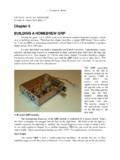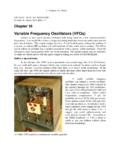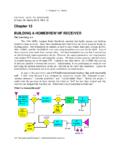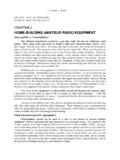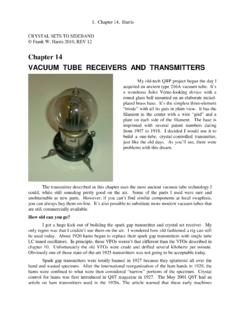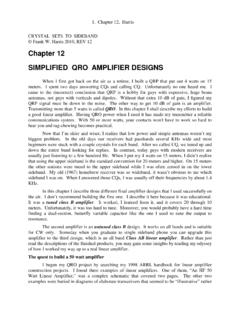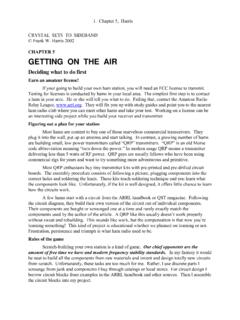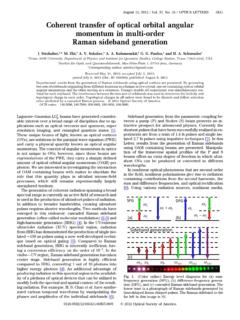Transcription of CRYSTAL SETS TO SIDEBAND - QRP Amateur Radio Club ...
1 1. Chapter 1, Harris CRYSTAL sets TO SIDEBAND A guide to building your own Amateur Radio station By Frank W. Harris, K IYE 3850 Pinon Drive Boulder, Colorado 80303-3539 Frank W. Harris 2002 ** Chapter 1 THE FASCINATION OF Radio Radio produces action at immense distances with no physical connection that can be perceived by our senses. A modern way to demystify Radio is to say that Radio is simply a kind of light that our eyes cannot see. To those of us addicted to shortwave Radio , it s an adventurous realm that can be explored. When we listen to our Radio receivers it is comparable to using the Hubble telescope to explore the heavens. Shortwave is fascinating because you can t predict what you are going to hear. You might hear a Radio broadcast from an exotic foreign capitol. You might pick up an SOS from a ship sinking in a storm or maybe weather reports from a Radio Amateur on Pitcairn Island. The next evening the same frequency band might be completely 2.
2 Chapter 1, Harris empty except for two hams on the other side of your own town discussing the Super Bowl. Or you might receive coded messages intended for some undercover spy lurking in our country. I m not kidding. I routinely hear such coded messages consisting of groups of letters on the and MHz ham bands. The codes are usually sent in Morse code, but sometimes you will hear a voice reciting the letter groups. Sometimes the woman announcer finishes by saying, Thank you for decoding this message! Since hams are forbidden to use codes or modulation modes that are not easily decoded, these communications are at least illegal. Yes, it s true that shortwave isn t as vital to world activities as it once was, but if there s any romance in your soul, shortwave is still entrancing and always will be. This book is about using Amateur Radio to recapture the adventure of early day Radio and bring it into the present. It is also about learning electronics and Radio technology.
3 If you can get through this book, shortwave Radio will still be fascinating, but no longer mysterious. Admiral Byrd at the South Pole I first became intrigued by shortwave when I read Admiral Byrd s book on his last expedition to the Antarctic. Admiral Richard Byrd was in the business of launching expeditions to explore the Earth s poles. These expeditions had no inherent commercial value except for book sales and sponsoring grants from companies hoping to gain visibility for their products. In order for Byrd to get those grants, the public had to be sufficiently interested in the expeditions to generate advertising value. With each polar expedition, finding new expedition goals that would be exciting to the public became increasingly difficult. Studying rocks, glaciers and penguins was scientifically important, but not particularly interesting to the public. By the 1940 s all the neat stuff, like walking to the North and South Poles had been done decades before.
4 On his last expedition to Antarctica, Byrd established a base on the Antarctic coast like all previous large expeditions. However, he succeeded in maintaining public interest by setting up a tiny second outpost on the polar icecap hundreds of miles south of the coast. Then he attempted to spend the Antarctic winter alone in his little under-snow cabin totally isolated from the world in the cold and dark. His one connection with his base camp at Little America and the outside world was Morse code Radio contact. Other than producing some interesting weather reports, the outpost had little real value. However, it did attract attention. Who could help but be captivated by the ordeal of a man totally isolated, hundreds of miles from the nearest humans? It was like being marooned on the moon, utterly alone. Byrd s messages were relayed from his big base back out to the rest of the world. As a boy I was fascinated by Byrd s lonely vigil. I imagined what it would be like to be shut off from the world for months on end.
5 I pictured Byrd bundled up in a fur parka huddled over his little table sending and receiving Morse code. His connection with the world was reduced to musical notes barely audible above the soft purring static of the polar night. The Morse tones came into his headphones and he wrote down their meaning, one letter at a time. The decoded messages appeared on his pad, one word at time. He fumbled with his pencil. Was that a C or a K? he asked himself. He pushed his indecision aside and kept writing down the new letters. Fretting about one letter can destroy the whole sentence. A radiotelegraph operator learns to focus on the stream of characters and not dwell on each one. After a few weeks in his frozen prison, Byrd began to suffer from headaches, nausea 3. Chapter 1, Harris weakness and confusion. His Morse code became harder and harder to read and his team back at Little America became greatly concerned. Unknown to Byrd, his cabin heater was leaking carbon monoxide and was slowly killing him.
6 Finally, when Byrd s condition became desperate, his crew drove hundreds of miles over the ice cap through winter darkness, howling wind and below zero temperatures to rescue him. Growing up at the end of the Morse code age As late as 1960, Morse code was still commonly used commercially and by the military. Since Morse code had an exotic sound, news broadcasts were routinely introduced by snippets of code. When the word NEWS is spelled out in Morse and repeated rapidly, it makes a pleasant, rhythmic, musical phrase that blends in well with Hollywood-style introduction music. The public often assumed that messages from the other side of the world arrived by Morse code, although in reality its importance had been fading since the 1930s. The Morse code used for Radio communications in the English language The dashes are three times longer in duration than the dots. A ._ G _ _ . M _ _ S .. Y _ . _ _ B _ .. H .. N _ . T _ Z _ _.
7 C _ . _ . I .. O _ _ _ U .. _ D _ .. J . _ _ _ P . _ _ . V .. _ E . K _ . _ Q _ _ . _ W . _ _ F .. _ . L . _ .. R . _ . X _ .. _ Numbers and Commonly Used Punctuation 1 . _ _ _ _ 3 .. _ _ 5 .. 7 _ _ .. 9 _ _ _ _ . 2 .. _ _ _ 4 .. _ 6 _ .. 8 _ _ _ .. (zero) _ _ _ _ _ (, comma) _ _ .. _ _ (. Period) . _ . _ . _ (/ slash) _ .. _ . My introduction to ham Radio was through Alexander ( Mac ) McKenzie. When I was a kid, Mac was the father of my best friend, Garth McKenzie. Garth s dad was a ham and had an alcove off the dining room crammed with Radio gear. In the 1940s, quality Radio equipment was packaged behind somber black aluminum panels 22 inches wide, eight inches high and mounted in tall racks. The controls were enigmatic black knobs with strange labels like grid drive and loading. The displays were usually just meters with equally arcane titles such as S-meter and plate current.
8 The McKenzie family had a cabin up in New Hampshire. Mrs. McKenzie and the kids spent most of every summer up at the cabin. Mac went up to New Hampshire on weekends when he could, but most of the time he stayed in touch with his family by Radio . A friend of Garth s 4. Chapter 1, Harris dad, Mr. Henny, lived near the McKenzies cabin. He was also a ham, so on Saturday mornings Mac had a regular schedule to talk with Mr. Henny using Morse code, or CW (continuous wave) as it is still known. I was intrigued when I heard about these scheduled contacts and wanted to see Mac operate his station. I arrived at the McKenzie house at the appointed time. Sure enough, right on schedule, Morse code appeared over the static. Garth s dad wrote down the letters on a pad. I watched over his shoulder and stared at his pencil tip. It was mesmerizing to hear the code and watch the words and sentences appear on the paper. Unfortunately I couldn t understand even one letter of what Mr.
9 McKenzie was sending, so I quickly tired of the one-sided conversation. In spite of that, Morse code had a mysterious, other-world quality and I was hooked. Among the other equipment in Mr. McKenzie s Radio shack was a Loran set. Loran was a long-range direction finder, the 1950 version of today s global positioning system (GPS). Mac demonstrated for me how to find latitude and longitude using a tiny green oscilloscope screen. The little round screen was only 2 or 3 inches wide and peered out from another one of those black, 22-inch wide black rack panels. Mac had it set up just for fun, of course. The Loran was designed for use on a ship and the McKenzie s house certainly wasn t going anywhere. The joy of building it yourself It was hard for an eight year old like me to imagine getting a ham license and affording all that massive equipment. The Loran was even more alien. What really turned me on was Mac McKenzie s television set. In the late 1940s, television stations were on the air, but no one I knew other than Mac actually owned a TV.
10 That wasn t surprising. TVs cost as much as an automobile. Talk about a luxury! Undaunted, Mac built his own television from old Radio parts and an army surplus, five-inch diameter, green oscilloscope tube. A real, white phosphor, (black and white) TV cathode ray tube cost a fortune back then, so Mac couldn t even afford the picture tube. And because the TV tubes were designed for magnetic deflection and the oscilloscope tube used electric deflection, Mac couldn t just copy the deflection circuits from an RCA TV. Instead, he had to design his own custom picture tube drive and sweep circuits. Perfecting a new circuit meant that it had to be built and tested one small piece at a time. Since Mac had little idea how large the final circuit would be, he couldn t assemble his TV in a cabinet right away. Instead, he built his TV as a giant breadboard circuit with all the glowing tubes, wires, resistors, transformers, capacitors and components all laid out in a huge spider-web matrix.
